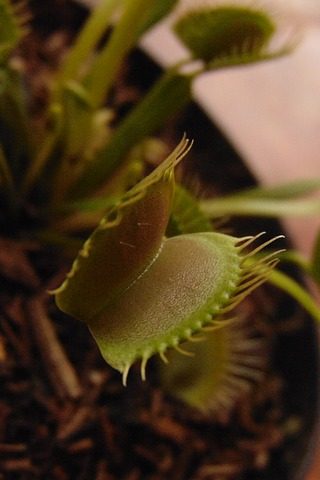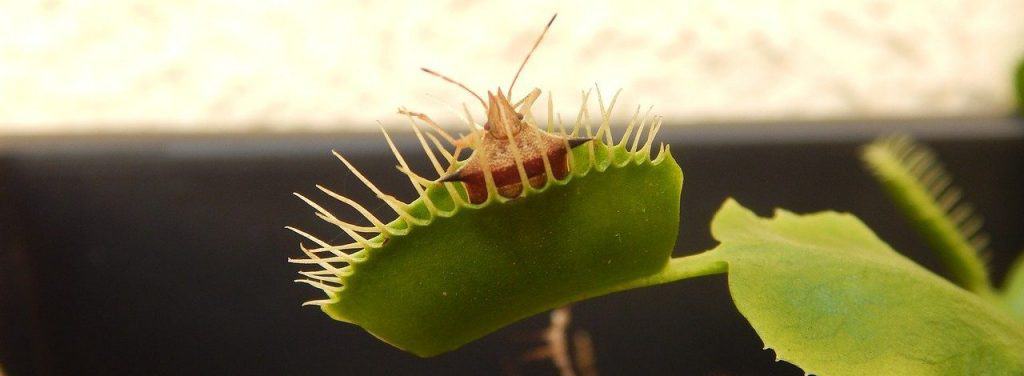Venus flytraps have evolved to be successful predators. Most plants get their vital nutrients from the soil, but Venus flytrap habitats do not contain enough nutrients. Therefore, these plants must obtain nutrients from another source. Venus flytraps extract vital elements from the insects they catch to boost their diet.
When you grow Venus flytraps, you must feed them to keep them healthy and let them thrive. I have grown Venus flytraps for several years. During many of those, I had my plants indoors. Indoors, they couldn’t catch prey naturally. So, I had to be systematic and feed them manually.
Before you start feeding Venus flytraps, you might have several questions. I will try to answer a common one: is it possible to feed dead bugs to Venus flytraps? It is convenient to buy a can of insects from the pet store. But would that work?
Can I feed dead bugs to my Venus flytrap? Yes. Growers can feed dead bugs to Venus flytraps. However, the feeding procedure is different from live prey.
Read on to learn about dead prey options, the feeding process, and more.
Dead vs Live Bug Feeding Process
You have the option to feed your plant live or dead prey. Yet, the feeding process is different.
Live Prey

Live insects are in motion. They will try to escape and will be challenging to handle. But, once you get the hang of it, you should be able to place the insect inside a trap. I like using chopsticks to hold live prey. Sometimes they scape, but it is a cleaner approach than using my bare fingers.
The movement of the bug will activate the trap. Each trap has sensory hair cells always monitoring contact. The trap only closes when something has touched the hair cells two consecutive times in a short period. So, make sure to insert the bug and let it move while touching the inside of the leaves.
Once the trap has closed, and the bug is inside, the process is basically done. First, the trap will close slightly. Then, the insect will try to fight its way out, but the movement will only make their scape more difficult. The plant will confirm it caught live prey and will keep its traps fully shut and will start producing enzymes.
Dead Prey
How to feed dead bugs to my Venus flytrap?
Venus flytraps are designed to consume live insects. In the wild, they do not eat dead prey. They only activate their traps due to active stimuli. When you introduce a dead insect, the trap won’t close automatically. You should make sure to stimulate those hair cells until your plant has caught the bug.
The first step is to get the trap to close. Then, you need to stimulate the leaf. Since the bug is motionless, the plant can notice the lack of stimuli and open again and reject the food. To avoid this, follow the second step: use your hands or tweezers (or chopsticks) to pressure the center of the trap on both sides. In that fashion, you produce stimuli, as those sensory hair cells have contact with the food. Finally, the leaves will produce enzymes and consume the insect slowly.
Step Summary
- Insert the insect inside the trap
- Stimulate sensory hair cells until trap closes (be gentle!)
- Use your hands or tweezers to put pressure (stimulate) on both sides of the trap (keep it up for several minutes)
- Monitor to make sure the leaves do not reopen
And that is it! Then, it takes several days or weeks for the plant to consume the bug. Now, let’s explore some menu options.
What dead bugs can I feed my Venus flytrap?
The Venus flytrap name is undoubtedly misleading. Many think that these plants eat flies exclusively. Yet, in the wild, Venus flytraps catch crickets, beetles, grasshoppers, spiders, slugs, flies, ants, and many other bugs. You can feed your plants with any of those insects and a few different options.
It is relatively easy to find mealworms, bloodworms, and crickets in stores. These meal options and nutritious and can be stored bought.
Interesting fact: Venus flytraps are not only insectivorous plants, but they are carnivorous plants. They can consume meat! In some uncommon scenarios, large Venus flytraps catch small frogs or rodents.
Still, my recommendation is to stick with an insect diet to avoid any potential mistakes that can kill your plant.
Important Sizes Considerations
Regardless of what bug is on the menu, you should always check the sizing of the food. The meal should fit entirely inside the trap so that it can close shut. A good rule of thumb is to pick a bug that is 1/3 of the size of the trap.

Sometimes it is difficult to find a small insect if you have a young plant that hasn’t reached its full size. Still, you got options. You can quickly chop a larger insect into pieces and feed your plant a small portion. Don’t worry; your Venus flytrap won’t notice ;).
Sizing is not the only considerations. Read the article below for a complete guide to feeding a Venus flytrap :
:
Where do I get dead bugs for my Venus flytrap?
You have two options:
- You can buy them
- Go bug hunting
The first one is a lot more convenient, especially considering that you can buy long term supply. All pet stores that carry reptile, fish, or bird supplies should offer at least one of these options: mealworms, bloodworms, and crickets. Also, Amazon or online pet stores carry those items.
Sometimes the insects are freeze-dried. That is entirely normal. You can still use them for your Venus flytrap. However, make sure to rehydrate them before feeding. Just add a few drops of water. I always use distilled water, even for this, only to be 100% safe.
Every now and then, I see a common question in carnivorous plant forums. Can I feed my Venus flytrap with a dead bug I found at home? You can certainly do so, but just make sure to check for these two items:
- Inspect the bug for any abnormality, such as bacteria growing or mold (you might not know how long it has been there)
- Again, check the sizing. Break up into pieces if necessary.
Long Term Effects: Live vs Dead Insects
What will happen if I only feed my plant with dead bugs? Are dead bugs nutritious? You might be inclined to think that dead bugs coming in a can or bag have lost their nutrition. It is not a crazy thought. Tons of human food that is frozen or canned loses a chuck of their nutrient. However, this is not the norm for insects.
Several studies suggest that feeder insects sold commercially contain several vital nutrients. For example, here is one study from Mark D. Finke: Complete nutrient content of four species of commercially available feeder insects fed enhanced diets during growth
In the study, they analyze different species of insects and record their nutritional value in various aspects. “Commercially raised feeder insects used to feed captive insectivores are a good source of many nutrients but are deficient in several key nutrients.” [1]
In the wild, Venus flytraps capture prey and supplement their diet with additional nutrients. Yet, they can survive without consuming prey. Since the insects you are providing are just a supplement. I wouldn’t be worried about the long term effects. Mealworms, bloodworms, cricket, and many others are considered to be nutritional snacks for larger animals. Their nutritional value will be enough to let your Venus flytrap thrive.
Sources
[1]https://onlinelibrary.wiley.com/doi/full/10.1002/zoo.21246

